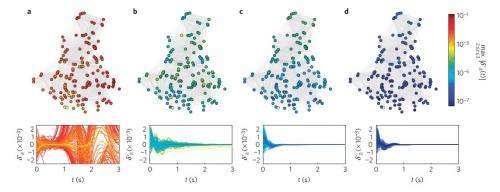February 22, 2013 feature
Better power grid synchronization may enable smart grids to self-recover from failures

(Phys.org)—Although the LHC has often been called the largest machine in the world, that title may be more appropriately given to something much more familiar: power grids. Consisting of thousands of generators and substations linked across thousands of miles, these networks form the backbone of society in developed countries. Yet most of the grids that power our modern economy are based on technology from the 1960s, even though power demands have changed dramatically since then. As a result of the additional strain, power grids have been failing more often, causing billions of dollars in business losses.
To combat these problems, researchers and power companies have been working on developing smart grids, in which the system's many components communicate among each other to improve the reliability and efficiency of electricity distribution. In terms of reliability, one of the biggest areas of research focuses on improving grid synchronization, so that every component that generates power oscillates at the same frequency (50 Hz in Europe; 60 Hz in the US). When one or more components become desynchronized, part or all of the grid loses its stability and power outages can occur.
So far, most studies on grid synchronization have focused on the role of the grid's structure as a network consisting of nodes (the power generators and subsystems that consume, produce, and distribute power) and links (the transmission lines that transport power). Changes in the network structure—such as adding or removing generators or transmission lines—can change the grid's synchronization and stability. But since changes in the grid's structure are mainly market-driven rather than theory-driven, it's often difficult to control the overall network design.
In a new study published in Nature Physics, researchers from Northwestern University in Evanston, Illinois; Stanford University in California; and Los Alamos National Laboratory in New Mexico have discovered that power grid synchronization depends on more than the network of transmission lines alone. They found that the leading factor for grid stability is not the network structure itself, which most previous studies have focused on, but the relation between the network structure, the state of the grid, and certain parameters of the generators.
The researchers showed that the stability of synchronized states in power grids can be enhanced by tuning generator parameters rather than modifying the entire network. As lead author Adilson Motter of Northwestern explained, this strategy works by quickly addressing any potentially damaging perturbations that arise in a stable grid.
"The rate at which small perturbations to the grid die out can be faster by a factor of 10 or more, according to our results," Motter told Phys.org. "Thus, the improvement can be substantial."
To identify which of the generators' parameters need to be tuned in order to achieve stability, the researchers mathematically derived a condition of the grid where grid synchronization is stable. They then used this condition to identify the important parameters, which involve inertia, damping, and regulation, allowing them to establish a "master stability condition" for the synchronization of power generators.
In the future, a smart grid could measure the state of the grid with high-speed sensors called phasor measurement units, and then communicate the data to an online control system that could adjust the parameters of the generators as necessary. In this way, smart grids could act as self-healing systems that can quickly recover from failures without human intervention, as well as help prevent failures from occurring in the first place.
The researchers hope that this finding that certain generator parameters can be tuned to enhance network stability will help guide the development of efficient controllers for smart grids and improve overall reliability. In addition to power grids, the results could also have applications in other networks where the dynamical units (generators in this case) co-evolve with the network structure. Examples include biological systems and other systems involving collective behavior.
More information: Adilson E. Motter, et al. "Spontaneous synchrony in power-grid networks." Nature Physics. DOI: 10.1038/NPHYS2535
Journal information: Nature Physics
Copyright 2013 Phys.org
All rights reserved. This material may not be published, broadcast, rewritten or redistributed in whole or part without the express written permission of Phys.org.




















